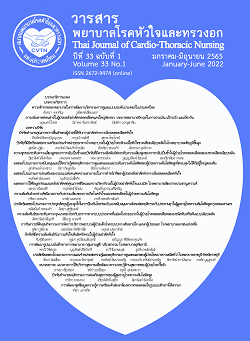Perioperative nursing in minimally invasive mitral valve surgery: a role of cardiac operating nurse
Keywords:
minimally invasive mitral valve surgery, perioperative nursingAbstract
Minimally invasive mitral valve surgery (MIMVS) is a procedure performed on the right fourth intercostal space. Since no incisions are made through the breastbone, this type of surgery has been known to be safe and effective when compared to traditional surgery. It does, however, necessitate more specialized tools and materials. The procedures and techniques used in the surgery differ from are used in conventional surgeries. For surgery to be successful and for patients to be safe, the following conditions must be met. To keep up with technology, cardiac operating room nurses must be able to learn about the instruments and equipment used in minimally invasive cardiac surgery (MICS). Assist the surgeon and surgical team during the procedure. Most notably, at every stage of surgery, the patient’s nursing guidance. This effectively preventions complications that may arise in patients undergoing minimally invasive mitral valve surgery.
References
The Society of Thoracic Surgeons of Thailand. Heart surgery statistics in Thailand 2001-2019. [updated 2021 May 16; cited 2021 July 20. Available from: https://ststhai.org/en/stats/.
Nishimura RA, Vahanian A, Eleid MF, Mack MJ. Mitral valve disease- current management and future challenges. The Lancet. 2016; 387:1324-34.
Cardiothoracic Surgery Unit, Department of Surgery FoM, Ramathibodi Hospital, Mahidol University. Cardiothoracic Surgery Unit Statistics 2016-2020.
Junwittayanujit T. Principle of minimally invasive surgery. In: Piempongkosol S, editor. Text book of practical surgery. Bangkok: Krungtepwetjasarn; 2010. p. 82-6. (in Thai).
Klieytim S, Pichaiphanupatt P. Ramathibodi soft tissue protector for a minimally invasive mitral valve procedure and video assisted thoracic surgery. Ramathibodi Nursing Journal. 2012;18(1): 1-8.(in Thai).
Teingtrakul S, Butsriphoom B. Perioperative nursing. Bangkok: Offset Plus company; 2015. p. 352. (in Thai).
Suttraput O. Essentials of heart surgery. Pathumthani: Thammasat University Printing house; 2018. p. 356. (inThai).
Lucà F, Van Garsse L, Rao CM, Parise O, La Meir M, Puntrello C, et al. Minimally invasive mitral valve surgery: a systematic review. Minim Invasive Surg. 2013;1-13.
Colangelo N, Torracca L, Lapenna E, Moriggia S, Crescenzi G, Alfieri O. Vacuum-assisted venous drainage in extrathoracic cardio-pulmonary bypass management during minimally invasive cardiac surgery. Perfusion. 2006;21(6):361-5.
Anastasiadis K, Antonitsis P, Deliopoulos A, Argiriadou H. From less invasive to minimal invasive extracorporeal circulation. J Thorac Dis. 2021;13(3):1909
Hinkle JL, Cheever KH. Brunner and Suddarth’s textbook of medical-surgical nursing: Wolters kluwer india Pvt Ltd; 2018.
Boonpeong P,Pradutwong S, Saebongbarn A, Kulwitit N. Surgery for one of the causes of emotional crises. Journal of Faculty of Nursing Science. 1998;21(1):15-21. (in Thai).
Nittayasupaporn S, Kaewnimitchai N, Namjuntra R. The relationship between personal factors, preoperative anxiety and preoperative information needs of open heart surgery patients. Thai Journal of Cardio-Thoracic Nursing. 2014;25(1):3-15.(in Thai).
Jaisawang K. Nursing care of patients undergoing mitral valve replacement surgery with medial incision and minimally invasive surgery: 2 case studies. Journal of Health Research and Innovation. 2022;5(1):125-36. (in Thai).
Pichaiphanupatt P. Guidline for perioperative nursing in OPCAB surgery: a role of cardiac operating nurse. Operative and Intensive Nursing Unit, Sirikit Nursing Service Department, Faculty of Medicine, Ramathibodi Hospital, Mahidol University. 2011. p. 1-98. (in Thai).
Sawangsri K. Pain management in patients undergoing open heart surgery. Thai Journal of Cardio-Thoracic Nursing. 2017;28(1):2-15. (in Thai).
Thepchai P, Naka K, Vachprasit R. Evidence-based practice for pressure ulcer prevention. Songklanagarind Journal of Nursing. 2018;38(3):38-51.(in Thai).
Forcillo J, Perrault LP. Armentarium of topical hemostatic products in cardiovascular surgery: an update. Transfus Apher Sci. 2014;50(1):26-31.
Charrière J-M, Pélissié J, Verd C, Léger P, Pouard P, de Riberolles C, et al. Survey: retrospective survey of monitoring/safety devices and incidents of cardiopulmonary bypass for cardiac surgery in France. The journal of extra-corporeal technology. 2007;39(3):142.
Ruengsakulratch P. Myocardial Protection. In: Chairoj S, editor. Essentials in Cardiothoracic Surgery. Bangkok: Idea Instant Printing; 2010. p. 117-35.(in Thai).
Hori D, Everett AD, Lee JK, Ono M, Brown CH, Shah AS, et al. Rewarming rate during cardiopulmonary bypass is associated with release of glial fibrillary acidic protein. The Ann Thorac surg. 2015;100(4):1353-8.
Carmona P, Mateo E, Casanovas I, Peña JJ, Llagunes J, Aguar F, et al. Management of cardiac tamponade after cardiac surgery. J Cardiothorac Vasc Anesth. 2012;26(2):302-11.
Meybohm P, Kohlhaas M, Stoppe C, Gruenewald M, Renner J, Bein B, et al. RIPHeart (Remote Ischemic Preconditioning for Heart Surgery) Study: Myocardial Dysfunction, Postoperative Neurocognitive Dysfunction, and 1 Year Follow‐Up. J Am Heart Assoc. 2018[cited 2018 Mar 26];Available from:http://doi.org/ 10.1161/JAHA. 117.008077.
Raiten JM, Ghadimi K, Augoustides JG, Ramakrishna H, Patel PA, Weiss SJ, et al. Atrial fibrillation after cardiac surgery: clinical update on mechanisms and prophylactic strategies. J Cardiothorac Vasc Anesth. 2015;29(3):806-16.
Zheng X-M, Yang Z, Yang G-L, Huang Y, Peng J-R, Wu M-J. Lung injury after cardiopulmonary bypass: Alternative treatment prospects. World J Clin Cases. 2022;10(3):753.
Devgun JK, Gul S, Mohananey D, Jones BM, Hussain MS, Jobanputra Y, et al. Cerebrovascular events after cardiovascular procedures: risk factors, recognition, and prevention strategies. J Am Coll Cardiol. 2018;71(17):1910-20.
Durongritchai W, Wattanadechakul N, Phewphong R, Mongkolrungreung S. The crinical nursing practice guideline for patients with coronary artery bypass grafting: research synthesis for application. HCA Journal of Health Science. 2016;20(39):143-56. (in Thai).
Downloads
Published
How to Cite
Issue
Section
License
Copyright (c) 2022 Thai Journal of Cardio-Thoracic Nursing

This work is licensed under a Creative Commons Attribution-NonCommercial-NoDerivatives 4.0 International License.
บทความนี้ยังไม่เคยตีพิมพ์หรืออยู่ในระหว่างส่งไปตีพิมพ์ในวารสารอื่น ๆ มาก่อน และกองบรรณาธิการขอสงวนสิทธิ์ในการตรวจทาน และแก้ไขต้นฉบับตามเกณฑ์ของวารสาร ในกรณีที่เรื่องของท่านได้ได้รับการตีพิมพ์ในวารสารฉบับนี้ถือว่าเป็น ลิขสิทธิ์ของวารสารพยาบาลโรคหัวใจและทรวงอก






